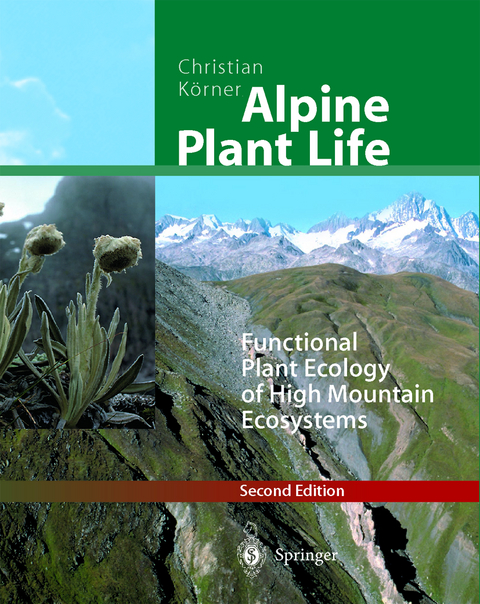
Alpine Plant Life
Springer Berlin (Verlag)
978-3-540-00347-2 (ISBN)
Christian Körner was born in 1949 in Salzburg, Austria, got his academic degrees from the University of Innsbruck, and became professor of botany at the University of Basel, Switzerland in 1989. He published over 300 scientific articles on plant-environment interactions and authored and coauthored numerous scientific books, including the leading plant science textbook Strasburger.
Plant ecology at high elevations.- The alpine life zone.- Alpine climate.- The climate plants experience.- Life under snow: protection and limitation.- Alpine soils.- Alpine treelines.- Climatic stress.- Water relations.- Mineral nutrition.- Uptake and loss of carbon.- Carbon investments.- Growth dynamics and phenology.- Cell division and tissue formation.- Plant biomass production.- Plant reproduction.- Global change at high elevation.- References (with chapter annotation).- Index.- Color Plates.
"The book may serve not only as an excellent reference source for ecophysiological topics, but also as a source of fresh ideas and inspiration for a much broader readership." (Leos Klimes, Folia Geobotanica, Vol. 41 (4), 2006)
" ... the best modern treatment of "functional ecology" of alpine plants that I have seen. ... this new edition added over 100 new references, new diagrams and revised and extended several chapters. ... an excellent summary and key to the study of plant-habitat relationships. ... should be a compulsory reading for every plant ecologist. In my library it is right next to the Larcher's Physiological Plant Ecology." (Botanical Electronic News)
"This is a fascinating synthesis on plant life at high altitude all around the world. There have been a number of studies on this topic, but the book by C. Körner is not just an addition to an already long list of publications. It attempts a synthesis based on a thorough functional analysis of the processescontrolling plant life in these extreme situation, and on a broad overview of many of the mountain areaas around the world. ... It is also a very useful tool for ecophysiologists, because all the questions addressed are carefully analysed under the different relevant view points. ... In brief, this book is a model study for ecologists and ecophysiologists." (Annals of Forest Science)
"Alpine Plant Life proved to be the right book for those who are either advanced gardeners or for those with scientific interests in the alpine ecosystems. This book is divided into 17 chapters beginning with the discussion of "Plant Ecology at High Elevations" and ending with an excellent discussion of "Global Change at High Elevation". ... Several color plates supplement the black and white photographs included throughout the book." (Diana Pederson, BellaOnline's Environment, June, 2004)
"Korner, a renowned alpine ecophysiologist, synthesizes the accumulated knowledge of generations ofalpine life scientists in this encyclopedic book. Introduces the alpine plant zone ... . Examines the interation between plant, wind ... . Discusses the physics of alpine soil ... . Reviews the uptake and loss of carbon ... . Analyses plant growth function, cell division ... . Extensively referenced, 218 figures, 4 color plates, and 47 tables. For ecologists and ecology students." (Northeastern Naturalist, Vol. 11(3), 2004)
"This book is the best modern treatment of 'functional ecology' of alpine plants that I have seen. The new edition, in hard copy book, costs less ... . At the same time, this new edition added over ... . This book is an excellent summary and key to the study of plant-habitat relationships. The Alpine Plant Life by Christian Koerner should be a compulsory (sic) reading for every plant ecologist." (Adolf Ceska, Botanical Electronic News, September 2004)
"The second edition has been revised, updated and enlarged. ... very clearly structured presentations of examples, discussions of arguments ... . As a result, the reader is not left alone with a wealth of details; rather, he/she becomes guided ... . In summary, Körner's "Alpine Plant Life" is an overview and manual for the scene, and will be a must for every scientific library. Moreover, it is very useful for the private book shelf for everybody who is engaged in research ... ." (Rainer Lösch, Phytocoenologia, Vol. 34(4), 2004)
"This is a fascinating synthesis on plant life at high altitude all around the world. ... is not just an addition to an already long list of publication. ... It is also a very useful tool for ecophysiologists, because all the questions addressed are carefully analysed under the different relevant view points. ... As such, it is a nice illustration of the way ecophysiological thinking may proceed. The best example ... . In brief, this book is a model study for ecologists and ecophysiologists." (Erwin Dreyer, Annals of Forest Science, Vol. 61(5), 2004)
"... a welcome second edition. ... It is a superb textbook - well written with plenty of good quality photographs, graphs and diagrams. It hits a happy compromise in being accessible to novices in upland areas and/or plants but with sufficient depth to leave the reader feeling that they have got to grips with the topic. The book starts with reviews of alpine life zones, climate, soils ... . A superb textbook that should be read and used by all ecology students."(Bulletin of the British Ecological Society, Vol. 35(1), 2004)
| Erscheint lt. Verlag | 14.7.2003 |
|---|---|
| Zusatzinfo | XI, 349 p. |
| Verlagsort | Berlin |
| Sprache | englisch |
| Maße | 193 x 242 mm |
| Gewicht | 1014 g |
| Themenwelt | Naturwissenschaften ► Biologie ► Botanik |
| Naturwissenschaften ► Biologie ► Ökologie / Naturschutz | |
| Schlagworte | Alpen • Alpenpflanzen • alpine ecology • Climate • Ecology • ecosystem • Flora • growth • high mountains • Hochgebirge • Klima • nitrogen • Nutrition • Ökologie • Ökosystem • Pflanzenökologie • photosynthesis • plant ecology • plants • Planzenökologie • respiration • Soil • Vegetation • Water |
| ISBN-10 | 3-540-00347-9 / 3540003479 |
| ISBN-13 | 978-3-540-00347-2 / 9783540003472 |
| Zustand | Neuware |
| Informationen gemäß Produktsicherheitsverordnung (GPSR) | |
| Haben Sie eine Frage zum Produkt? |
aus dem Bereich



